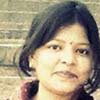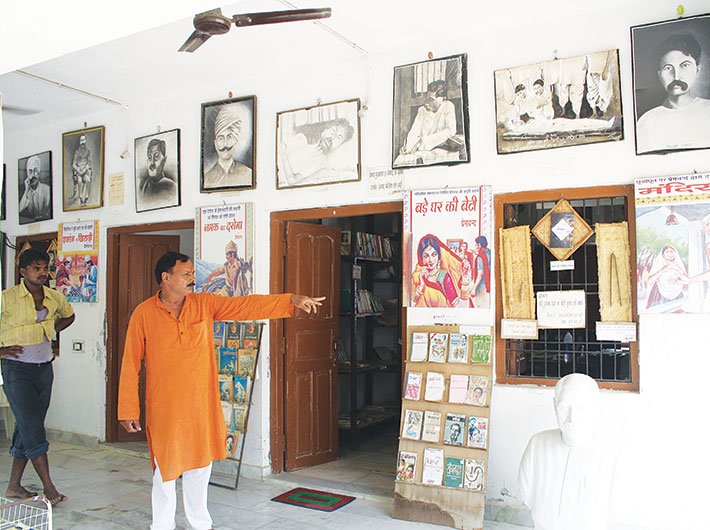Hori, Nirmala, Bade Bhai Saheb and other characters are still alive in Lamhi village
On the outskirts of Varanasi, the Azamgarh road leads to a small hamlet, Lamhi, the place where Munshi Premchand was born, lived and left behind some of the most marvellous pieces of modern Hindi literature. His stories, which revolved around the lives of villagers during the pre-independence era, are still etched in the minds of Hindi literature lovers.
As you enter the village from a connecting road on the highway, a huge gate with figurines of prominent characters that the litterateur weaved (Budhi Kaki, Hori, Nirmala), welcomes the rare literature aficionado.
A few steps away from the entrance of the village lies a white two-storey house of the great Hindi-Urdu writer. This vacant house is where he spent most of the 56 years of his life, and penned hundreds of manuscripts – some of which were published after his death.
The ageing walls of the house are plastered with limestone mix, hinting a recent renovation. Presence of old-fashioned black electric switches on one of the sidewalls rings the nostalgic bells. A few stone slabs carved with scenes from his famous stories, accompanied by memorable lines, lie scattered on the floor of the house.
The verandah leads to another room filled with sunlight – a perfect setting of a writer’s corner. One might guess that this would have been Premchand’s study.
“He was a people’s man. He loved observing and interacting with people. Most of his interactions with villagers would happen at the well nearby. But he also preferred writing in seclusion,” says Akhilesh, a man in his fifties who lives in the neighbourhood, and who used to hear about Premchand from his father and grandfather who knew the man.
This house without an owner and furniture remains open for all and is maintained by the Uttar Pradesh culture department. Despite the rich legacy, the house stands neglected in one corner of the village. On a typical day, it receives barely four-five visitors from outside the village apart from some locals who are still, in a sense, living in Premchand’s era.
The writer, born as Dhanpat Rai Srivastav in 1880, wrote more than 300 stories, 15 novels and three dramas in Hindi. He also wrote in Urdu under the pen name ‘Afsana Kuhan’.
Lamhi village is the source of the inimitable characters and their diverse destinies in all-time masterpieces like Nirmala and Godan. Some of his stories including Iddgah, Do Bailon ki Katha, Gaban and Shatranj ke Khiladi have been adapted into films and popular theatres. Like the characters in his stories, Lamhi’s residents continue to yearn for a better life. As seen in a sepia tone, the problems of the villagers are no different than Hori’s longing for a cow (Godan); Ramanath’s impoverishment and aspirations of the middle class (Gaban) and Nirmala’s sacrifice as a woman married to a much older man (Nirmala).
Lamhi remains relatively unknown to many though it falls in prime minister Narendra Modi’s constituency (Varanasi) and is not far from Jayapur, the village he has adopted under the sansad adarsh gram yojana. Yet, the village manages to pulsate with memories of Premchand and is keeping its legacy intact, without much support from authorities.
Keeping the legacy alive
Suresh Chandra Dubey is one such Premchand enthusiast who has turned a part of the writer’s house into a library without taking a penny from the government. “Munshiji’s characters are still visible in the village. Try looking for Hori (from Godan) and you will find a man sitting outside his mud house resembling the original character. Similarly, Nirmala, Bade Bhai Saheb and other legendry characters are playing their part unknowingly. The only difference is that now no words are written for them,” he says. Dubey is the president of Premchand Smarak Nyas, a literary organisation dedicated for taking care of the tangible and intangible heritage of Premchand in Lamhi.
Started 15 years ago with some 100-odd books, Dubey’s free-membership library now has a collection of 2,000 books, journals, and rare periodicals. Some books in the library are donated by Premchand fans, while some were bought from different book markets including the Sunday book bazaar of Daryaganj in Delhi. “The library started without any bookshelf. We used to arrange books on a table and the floor. Later, an organisation donated us bookshelves. A few years later, a private club donated a new set of books. While initially there were no visitors at all, today we are one of the few functional and rich libraries in Varanasi, despite operating from a village,” says Dubey.
The village has book lovers in every household and most of them are women. Madhu, a housewife who has come to the library, says, “I am really fond of women-centric stories and novels by Munshiji. There is no better way to relax after a day’s work than to read his stories.”
Into the oblivion
In 2005, on the 125th birth anniversary of the novelist, then Uttar Pradesh chief minister Mulayam Singh Yadav had announced renovation and reconstruction of the house which was in a dilapidated condition. A year later, then union minister S Jaipal Reddy laid the foundation stone. But it was only in 2011 that the house was fully renovated at a cost of '9.3 lakh. Politicians had made tall claims and promises –converting the house into a museum was one of them. They even talked about linking the village with various tourism and cultural hubs.
During the same time, construction of a research institute, under Banaras Hindu University, adjacent to Munshiji’s house was also planned.
However, till date, neither the research institute nor the promised tourist and cultural projects have seen the light of the day. According to UP regional cultural officer Ratnesh Verma, once the research institute is functional, other schemes pertaining to the village and Premchand’s house will be taken up.
The only tribute the state pays to the novelist is the Lamhi Mahotsav celebrated every year on Premchand’s birth anniversary, July 31.
Towards the e-edge
In 2014, the village captured the attention of national newspapers after the government chose it to become the first e-village in UP. The villagers cut a cake on the 135th birth anniversary of the novelist this year and decided to commemorate the occasion as the village’s anniversary. They remain unperturbed by the apathy of those who had promised to do more to show respect for the great son of the soil. In the meanwhile, the government had set up a team of Lekhpal and village development officials to carry out a survey to connect Lamhi with the rest of the world under the e-village project.
“Data on villagers’ personal information including income, birth and death details, family size, etc. is being sought. The data would be digitised and then put on an online portal. Every villager will be given a user login and password to access the data, maintain records and avail services,” says Meera Devi, pradhan, Lamhi.
“The village has received two computers to complete the work from the community centre, which is soon going to be Wi-Fi enabled. Though there is no declared deadline, we are hoping that the database will be ready in five-six months,” she said.
About this new development, villagers are hopeful as well as sceptical. “The only attention we get is at the anniversary celebrations when projects are announced; it all goes into the oblivion till another Lamhi festival is celebrated,” says Akhilesh. Dulari Devi, whose understanding of computers comes from what she has been told by her 13-year-old son, says, “I don’t know much about the e-village project. What we want is regular electricity. We see eight to 10 hours of power cut every day.” Durga Prasad believes that the project is just being hyped.
With an approximate population of 2,000, the village manages with one consultant doctor (no permanent medical officer) at the primary health centre, one primary school and two secondary schools.
swati@governancenow.com
(The article appears in the December 16-31, 2015 issue)

